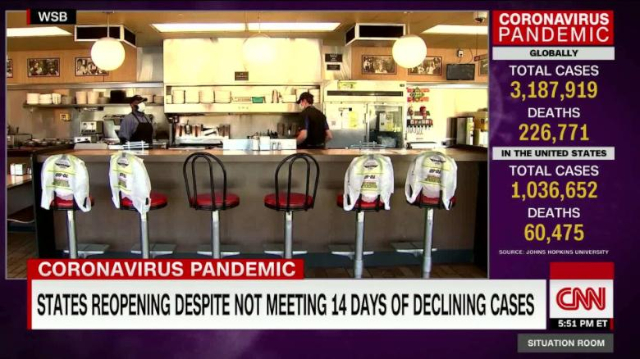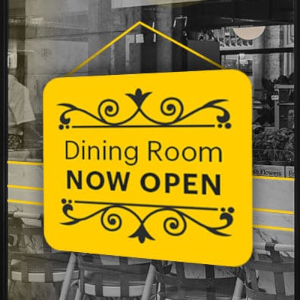Restaurants are starting to re-open for dine-in – albeit under ultra-cautious operating restrictions – in most parts of North America. This in spite of spiking new-case numbers in jurisdictions where restrictions have eased the most. But there are other consequences associated with re-opening too soon…
 Big News: But many restos re-opening for dine-in service face
Big News: But many restos re-opening for dine-in service face
crushing costs, and customers aren’t flocking back…
McDonald’s and other fast food chains recently released food handling and service practice manifestos – some dozens of pages long – that all outlets must follow if they want to re-open for dine-in service under eased government lock down regulations. And the resto chains have hinted that some of the changes they’re instituting now may become permanent. Ie. – don’t expect those Plexiglas barriers at the order counter to disappear anytime soon, and get used to asking the counter staff for your Sodas, Condiments and napkins.
Earlier this week, McD’s responded to a call from its franchisee lobby group to stick with shorter, simpler menus even after the pandemic crisis passes. And there are lots of good reasons to do that.
Due to Meat shortages in the U.S. caused by massivie COVID-19-associated processing plant closures, Beef prices rose by as much as 87 percent from February of this year to May. They were already comparatively high, even before the pandemic crisis. By comparison, Chicken prices rose by 23 percent over the same period.
But there’s more…
But there are other consequences of the COIVID-19 experience that resto chains are also grappling with. For now at least, prices are expected to rise as operators face big overhead increases associated with process and service precautions they are being forced to make to keep their employees and customers from spreading the novel coronavirus. Not that they begrudge making them, but think about it…
First, operators will have to absorb the cost of masks, gloves and staff-customer barriers, special social distancing signage and other compliance assists. The barriers alone are not cheap.They can cost from $75 up to $150 or more each, depending on size and mounting systems.
Resto dining room occupancy rates have been slashed to preserve the mandatory 6 ft. / 2 m separation between dine-in family groups. That results in an immediate dive in the potential revenues the restos can expect.
Cleaning and hygiene routines have been intensified, which will cost more in supplies, and lost time between table turnovers.
Perhaps the costliest aspect of the enhanced pandemic re-opening mandates will be wages, benefits, uniforms and training for new employees added to perform sanitation and other tasks that the restos didn’t have to provide for back before COVID-19, when most Fast Food dining rooms were massively self-serve.
Folks aren’t flocking back
Add to all this the cold, hard fact that diners are not lining up at most restos that have recently re-opened dine-in service. Surveys indicate that an overwhelming number of fans are sitting tight at home until social distancing restrictions are finally lifted entirely and trusted medical authorities tell them it’s safe to go out and mix with others again.
Massive cost increases = brutal price increases
According to a recent Business Insider article, operating costs associated with re-opening retos for dine-in service may average as much as 38 percent. This in an industry where profit margins have always been paper thin – a few percent as most – and operators have had to rely on fast service to pump out mass sales to make money. This can only mean significant menu price increases. But the good news is, all the players in the arena will b e equally affected, so no one gets any kind of competitive advantage out of the situation.
On the down side, fewer folks may come back to their previous resto haunts – at least not as often as they used to – if prices rise. What does a, say, 40 percent menu price hike look like?
- A Big Mac would rise from $5.69 to 7.96
- A Quarter Pounder with Cheese Extra Value Meal would rise from $9.49 to $13.49
- A Medium order of Fries would rise from $2.89 to $4.04
- A Medium Soda would rise from$2.24 to $3.14
- A Medium Premium Roast Coffee would rise from $1.79 to $2.50
And those are just a few popular menu items from one brand (based on average prices; prices may vary regionally).
What resto operators are doing…
CEO John Davie of Buyers Edge Platform, an industry consulting firm, told Business Insider: “Generally, if the prices are significantly higher for 30 days or more, restaurants will have to start making decisions.” That 30-day threshold passes some time ago.
Even before officials even talked about re-opening restos for dine-in service, some operators added ‘COVID-19 surcharges’ to their prices to cover rocketing operating costs.
In general, restos are being ultra-cautious about raising menu prices. They’re going to do it slowly and, they hope, relatively painlessly. But they will have to do it.
In the interim, operators have come up with some tactics to avoid posting or advertising higher menu prices. They’ve concentrated on offering carefully crafted Meal Deals and limited time specials (see any recent weekly Fast Food Week post). But operators can’t afford to offer those forever. They’re just a bridging exercise to buy some time. Look for staged, gradual menu price increases while operators wait to see where food prices are going to end up and how much of the current enhanced sanitation and service cost increases remain when all pandemic-related restrictions are removed.
My take
I can see some resto brands mandating increases that reflect realistically their added operating costs so they can say, after the crisis is over, that they’re pleased to be able to lower prices again as a reward to their loyal fans. But don’t expect to see restaurant menu prices to ever subside to pre-COVID-19 levels…
~ Maggie J.

